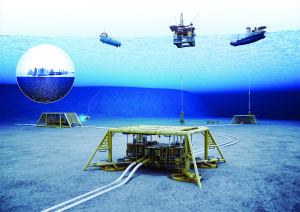I’ve just spent that last couple of days in Houston at the annual Offshore Technologies Conference (OTC). Like many things in Texas, this event is HUGE – with some 90,000+ attendees from around the globe kicking tires and otherwise assessing some really LARGE pieces of metal. I’ve been here in previous years, first in 2010 during the BP oil disaster, and again in the following year to fill in some of the gaps.
The scale of this industry is hard to imagine. Even up close like I get at the OTC where well heads, “Christmas Trees,” generators, and manifolds weighing over 100 tons are on the stadium floor it is still hard to imagine. The big drill ships, “semi-submersibles,” and floating production, storage, and offloading (FPSO) rigs can house a few hundred workers, produce thousands of barrels of oil a day, and command day-rates upward of $500,000. In one presentation on concurrent field developments off Brazil the presenter was discussing the provision of ten duplicate drill ships…
All of this is turning the global outer continental shelf into factory floors for the production of fossil fuel. I have often mentioned my concerns that these ultra-high pressure deepwater operations are producing a roar of mechanical sounds that will mask biologically important sounds of fish, marine mammals, and invertebrates. And that these noises will increase stress in marine biota.
What I find particularly troubling is the rapid rise in deep sea acoustic modems. Increasingly navigation beacons, current and depth profilers, autonomous vessel control, equipment condition monitors, and multi-nodal communication networks are being deployed that operate in the 20kHz-100kHz frequency range at transmission powers of 195-210dB (re: 1µPa). These are using Frequency or Phase “Shift Key” coding that needs to be sharp and screechy for message clarity. The typical range is 10-15 km, so within 10-15km of any of this equipment animals – particularly dolphins, seals, and porpoises will be subjected to this loud haze of nasty noise.
And nobody is thinking about this. The folks who are developing all of this equipment are not biologists, they’re engineers.
At this point we have a lot of catch-up work to do. There have been few studies examining how porpoises respond to some of these signals (they avoid them) but we don’t know much about the antagonizing characteristics of the signals, and whether they could be modified to not spook marine mammals. And while there are regulations in place that these signals would fall under, so far US regulatory agencies do not seem worked up about them yet.
We will be in Washington DC over the next week to bring these issues to the table. Hopefully we can get the ball rolling on some mitigations.

